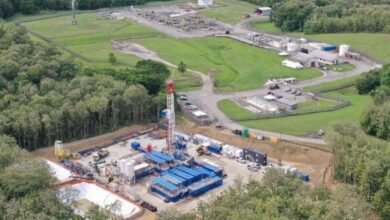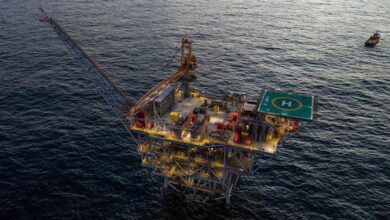Apache: Lower prices make gas projects hard to justify, technology is opportunity to ‘think positively’
By Linda Hsieh, assistant managing editor

As a company that prides itself on being “lean and mean” and being able to move fast when the economics of a project line up right, Apache Corp believes it is well-positioned to capture the upside to any increases in commodity prices in the coming months. “We like to be in a place where we can make things happen pretty quickly,” said Graham Brander, director of worldwide drilling for Apache.
When crude oil prices hit $70/bbl a few months ago, the company was able to put a number of drilling rigs back into the field, mostly in the Permian Basin. The Permian Basin is Apache’s main onshore US oil province, where the operator had six rigs active as of early October. “By the end of the year, we’ll probably have about 12 rigs operating there,” Mr Brander said.
You could look at that number as a doubling of current activities – from six to 12 – which is definitely a move in the positive direction. On the other side, you might realize that 12 would still be less than half of the 25 rigs Apache had in the area just before the downturn began. “We went from 25 rigs to one over a period of about three months,” Mr Brander recalled.
He noted that Apache had to significantly pull back on drilling programs, not just onshore US but worldwide, over the past year. “We’re very much a company that lives within our cash flow. … As the cash flow changed dramatically, we had to dramatically change our drilling activity as well,” he said.

Now, as the industry dusts itself off and tries to pick back up after falling to bottom in the first half of 2009, many are looking to oil and gas companies – big and small, IOC and independent – for signs that they’re ready to drill again.
For Apache, Mr Brander noted that as of early October, the company hasn’t determined its specific work programs for 2010. However, in general, they will continue to push forward with growth areas like Egypt and the Canadian shales, he said.
Obviously, the level of commodity prices will be the determining factor when weighing potential projects, but almost as important is cost, both on the rig side and the service side.
“While we have seen some changes from the very high-cost environment we had in 2008, we believe there’s still some ways to go in some areas of the business. If the cost structure element changes to make the economics of the project beneficial, I think there will be stability in the rig market,” he said.
Although the price of oil has been able to stay in the $60 to $70 range, “natural gas is very unencouraging right now,” Mr Brander said.
The development of the US shale plays have so far been a double-edged sword for the industry. On one hand, it’s providing lots of drilling opportunities and a large resource base for North American gas consumers. “But on the other side of it, the news that we have a lot of gas resources means that there will be a business environment where the power of the buyer will be more significant than the power of the supplier. Lots of available gas means there is likely to be an environment of lower gas prices for a while,” he said.
Commenting on the potential for additional gas drilling in the coming year, Mr Brander added that, with natural gas prices still hovering in the $3 to $4 range, “it makes it tough to justify doing gas projects.”
“If we can’t get a return out of (a project), then we don’t take that project onboard,” he continued. “I wish I could say we’re going to commit to all sorts of drilling, but we operate in a very competitive environment where project economics have to be justified for everything we do. We are strongly focused on delivering cost leadership projects that will give us an advantage as a low-cost operator.”
KEY GROWTH AREAS
Apache currently does not hold any acreage in the US shale plays, but Mr Brander did not rule out the possibility of his company entering hot areas like the Haynesville and Marcellus. “Apache has always been an acquisitive company. If there is something of interest to us, we’ll announce it when we announce it. We evaluate opportunities all the time.”

Where Apache is definitely pushing ahead in 2010 is in the Horn River Basin in northeast British Columbia. Drilling results from the first half of 2009 have already strengthened the company’s earlier estimates that individual horizontal wells in this Canadian shale play can recover up to 10 billion cu ft of natural gas. Three wells at Two Island Lake were brought on-line this year at gross initial production rates of more than 16 million cu ft/day.
The company and its partner EnCana have been able to increase fracture stimulations in the Horn River to as many as 14 stages per horizontal section, which Mr Brander called “a good performance compared with what we think other companies are doing.”
The element of frac’ing horizontally and putting long horizontals into shale plays is still a relatively recent technique, but projects like the Horn River proves that “we’re just starting to push the boundaries of how many (horizontal frac’s) we can put into a wellbore,” he said.
Improvements in production that can be realized with these advanced fracturing techniques vary from field to field, even well to well. “It’s not a simple answer,” Mr Brander said, but it’s definitely a good concept worth pushing forward. Apache expects to have 32 wells on production at Horn River by the first quarter of 2010.
Another key growth area for the company is Egypt, where records for daily production were achieved in Q2 this year, at 163,000 bbl/day for oil and 754 million cu ft/day for gas.
Also this year, Apache made a discovery in Egypt with the Falcon-1x well, which tested at 4,400 bbl/day of oil in the Alan El Buieb (AEB-3D) formation. Hydrocarbon pay zones were also encountered in the AEB-6 and Jurassic Safa formations. Additionally, 37 miles west of Falcon-1x, the Hydra-5x appraisal well encountered hydrocarbons in the Jurassic Upper Safa formation.
Egypt “has been a focus area for us for a number of years and will stay that way… it has been and continues to be a very interesting area to operate on the drilling side,” Mr Brander said.
Apache also holds a unique position in the North Sea, where it owns the Forties Field and where “the downturn has actually helped us in some areas of managing our business,” he said.
As the market deteriorated there, a number of experienced personnel became available for its platform operations that had been utilized in other parts of the industry. “We’ve been able to get access to these folks. Plus, we’ve clearly seen an improvement in the quality of maintenance and quality assurance of equipment and tools delivered to the rig site. … It’s helped to reduce our nonproductive time.”
And because the company has five platforms on the Forties Field, four with drilling rigs they own, the company’s been able to maintain its activity level through the last year.
“To date we’ve drilled 16 wells and, by the end of the year, we should have 20 under our belt. In addition to that, we’ve completed a large number of workovers as well,” he said.
TECHNOLOGY IS KEY
Noting the “doom and gloom” that some companies in the industry are experiencing, Mr Brander pointed to one positive trend he’s noticed, and it goes back to technology, like those Apache’s using in the Canadian shale plays.
“A number of techniques have come out specifically on the frac’ing and directionally drilling side that may change the economics of drilling in existing fields,” he said. These techniques could change the cost structure for depleted fields and potentially expand the scope of their development.
“We’ve got a large number of mature fields in the US, hundreds of wells with very low production rates… If we can expose a lot more reservoir sand by being able to directionally drill wells through thin sands that had perhaps been bypassed … we can open up more of the reservoir and access pockets that weren’t produced in the past. We’d get an opportunity to do some interesting things there,” he said.
“There is at least an opportunity to think positively about some of the existing fields because of new technologies and the cost changes those new technologies bring to the process.”
And it does all boil down to cost, both for the operators who drive the drilling programs and the drilling contractors and service companies who depend on those drilling programs to survive.
“The sphere for competitors is very large for our business; similarly so for the drilling contractors and service companies… the smartest that are going to survive are ones that can hit that unit technical cost and make it work for the type of projects (operators) have in their portfolios,” Mr Brander said. “Anything that can be done to get a low cost structure in place for services and rigs will do nothing but encourage us to go back to work and try to maintain some activity.”





Thank this Journal paper for work help
Thank your journal paper for my work helps.